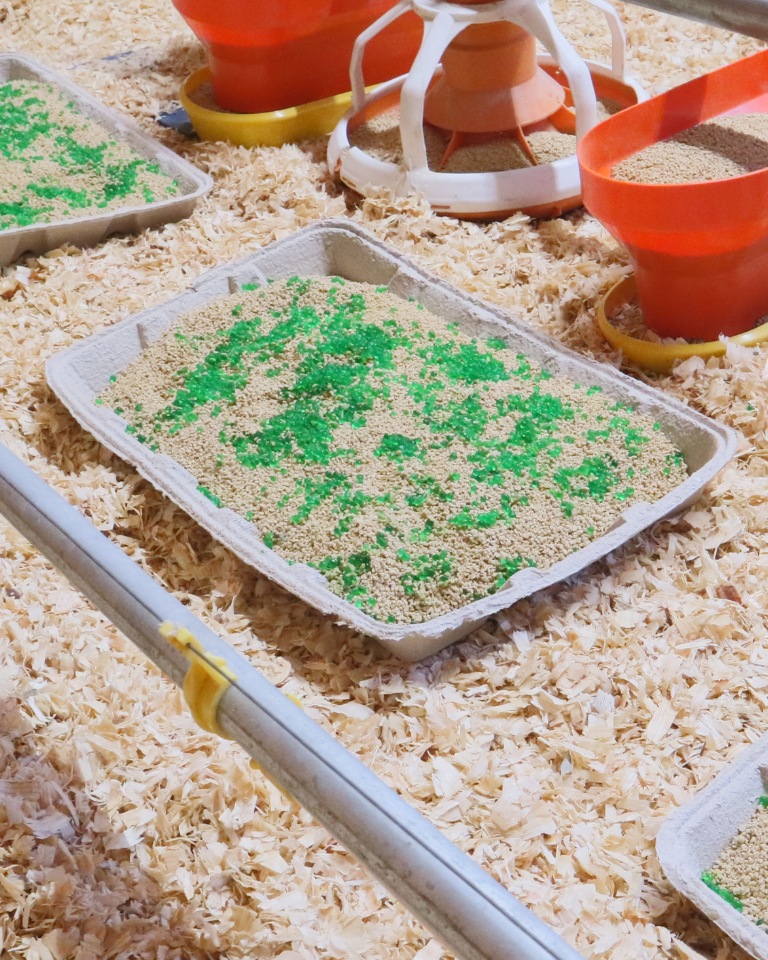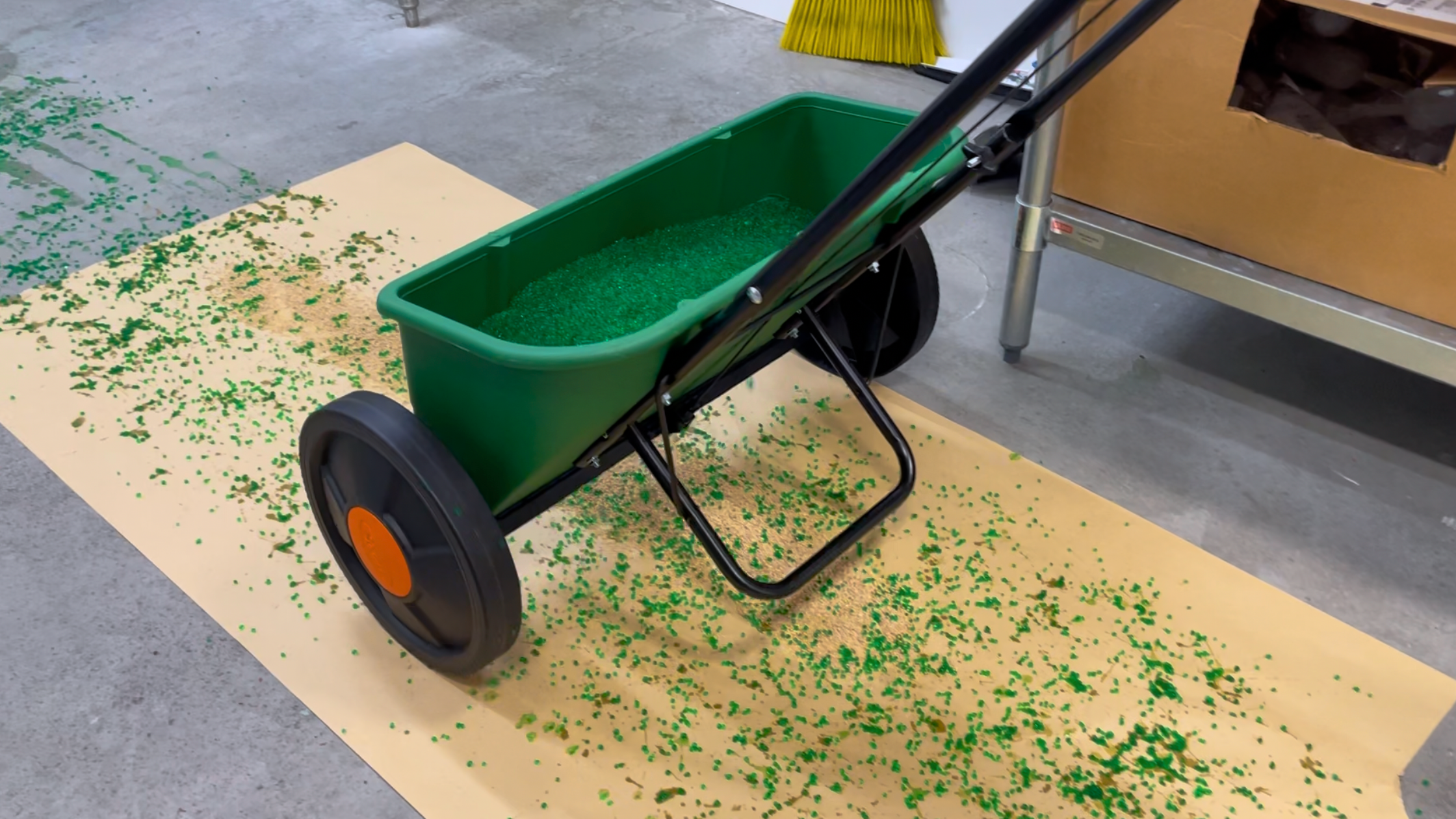Summary
DESCRIPTION OF PROBLEM
MATERIALS AND METHODS
Ethical Statement
Experimental Design

Figure 1. Images of a) AquaBeads® and feed flats at placement for the b) Control (non-treated), c) AquaBeads®, d) Preference group. AquaBeads® were provided at 1.5g/poult or 45g total per pen. For the AquaBeads® group, 45g was evenly allocated between the two feed flats, whereas 45g was added to a single feed flat for the AquaBeads® Preference group.
Growth Performance Measures
Crop and Lower Ileum Fill
Crop Fill Assessment
Feed Flat Activity
Table 1. Ethogram of behaviors.
| Behavior | Description |
|---|---|
| Active | Poult is walking, in which propulsive force is derived from the action of the legs, foraging by scratching with feet and/or pecking at the ground with the beak while standing or walking, or standing by maintaining an upright position on extended legs. |
| Passive | Poult has both hocks and/or breast resting on the ground, the head may or may not be in contact with the ground. |
| Total | Active + Passive |
Statistical Analysis
RESULTS AND DISCUSSION
Performance
Table 2. Effect of AquaBeads® supplementation on 10-day body weight (BW, g), BWG (g/poult), feed conversion ratio (FCR), and mortality (%) performance parameters in turkey hen poults.
| Group | BW (g) | BWG (g) | FCR1 | Mortality (%) | |
|---|---|---|---|---|---|
| d0 | d10 | d0-d10 | d0-d10 | d0-d10 | |
| Control | 52.87 ± 0.26 | 118.16 ± 1.75b | 65.19 ± 1.73b | 1.88 ± 0.05 | 8/240 (3.33) |
| AquaBeads® | 52.49 ± 0.26 | 124.44 ± 1.65a | 72.08 ± 1.61a | 1.83 ± 0.06 | 5/240 (2.08) |
| Preference | 52.90 ± 0.26 | 124.29 ± 1.63a | 71.36 ± 1.63a | 1.79 ± 0.02 | 12/240 (5.00) |
| p-value | NS | 0.011 | 0.006 | NS | NS |
- 1
-
Motality adjusted. NS indicates no significant differences observed.
Table 3. AquaBeads® presence in the crop and lower ileum at 15 and 45 minutes post-placement.
| Group | Crop | Lower ileum | ||
|---|---|---|---|---|
| 15 min (%) | 45 min (%) | 15 min (%) | 45 min (%) | |
| Control | 0/8 (0.00) | 0/8 (0.00) | 0/8 (0.00) | 0/8 (0.00) |
| AquaBeads® | 4/8 (50.0) | 8/8 (100.0) * | 4/8 (50.0) | 6/8 (75.0) |
| Preference | 7/8 (87.5) | 7/8 (87.5) | 2/8 (25.0) | 5/8 (62.5) |
Table 4. Effect of AquaBeads® supplementation presence (AquaBeads®), absence (Control), or choice (Preference) on 24h crop fill.
| Group | 24h crop fill1 (%) | ||
|---|---|---|---|
| empty | hard/full | soft/full | |
| Control | 8/40 (20.0) | 1/40 (2.5) | 31/40 (77.5) |
| AquaBeads® | 6/40 (15.0) | 2/40 (5.0) | 32/40 (80.0) |
| Preference | 7/40 (17.5) | 1/40 (2.5) | 32/40 (80.0) |
- 1
-
Scoring system used to assess crop fill: 0=empty, 1=hard/full (feed only), 2=soft/full (water and feed). No significant differences were observed between treatments (Chi-square).
Behavior
Table 5. Effect of AquaBeads® supplementation presence (AquaBeads®), absence (Control), or choice (Preference) on the percentage of total, active, and passive turkey poults on feed flats during the first hour post-placement.
| Behavior category (% poults) | Treatment | |||
|---|---|---|---|---|
| Control | AquaBeads® | Preference | P-value | |
| Total | 20.09 ± 3.28 | 27.20 ± 3.28 | 28.00 ± 3.28 | NS |
| Active | 15.10 ± 2.39b | 25.40± 2.39a | 22.80 ± 2.39ab | 0.006 |
| Passive | 3.20 ± 1.17a | 3.03 ± 1.14a | 0.43 ± 0.43b | 0.022 |
Table 6. Effect of the presence or absence of AquaBeads® on the percentage of total, active, and passive turkey hen poults in the Preference group on feed flats during the first hour after placement.
| Behavior category (% poults) | Preference pen feed flats | ||
|---|---|---|---|
| With AquaBeads® | Without AquaBeads® | p-value | |
| Total | 16.10 ± 0.59a | 11.90 ± 0.59b | 0.001 |
| Active | 13.72 ± 0.63a | 9.06 ± 0.63b | 0.001 |
| Passive | 0.73 ± 0.28b | 1.23± 0.36a | 0.001 |
CONCLUSIONS AND APPLICATIONS
-
1.
Supplementation with AquaBeads® improved the 10-day performance of turkey hen poults, suggesting it is an effective feed supplement that promotes early performance.
-
2.
AquaBeads® stimulated poult interest in feed flats by encouraging eating and foraging behavior during the first hour post-placement. Given the strong attraction and consumption observed, follow-up studies should investigate how AquaBeads® can serve as a novel delivery vehicle for nutrients such as hydration, energy sources, and dietary ingredients.
-
3.
Poults exhibited a preference for AquaBeads®, with a higher percentage not only present on the feed flats but also actively engaging in foraging for AquaBeads® compared to flats without AquaBeads®. However, the scope of the current study was limited to short-term effects during the first 10 days post-placement.
-
4.
Overall, these results support the potential of AquaBeads® as a practical early feeding solution for turkey poults. Future research is needed to validate these findings and assess the long-term implications of AquaBeads® supplementation in a commercial setting to determine the overall growth performance of commercial turkeys. These additional studies could also investigate whether AquaBeads® supplementation offers benefits beyond early growth, such as improved gut health, immune function, or resilience to environmental stressors.
Article originally published in Journal of Applied Poultry Research, linked here.



Leave a comment
All comments are moderated before being published.
This site is protected by hCaptcha and the hCaptcha Privacy Policy and Terms of Service apply.